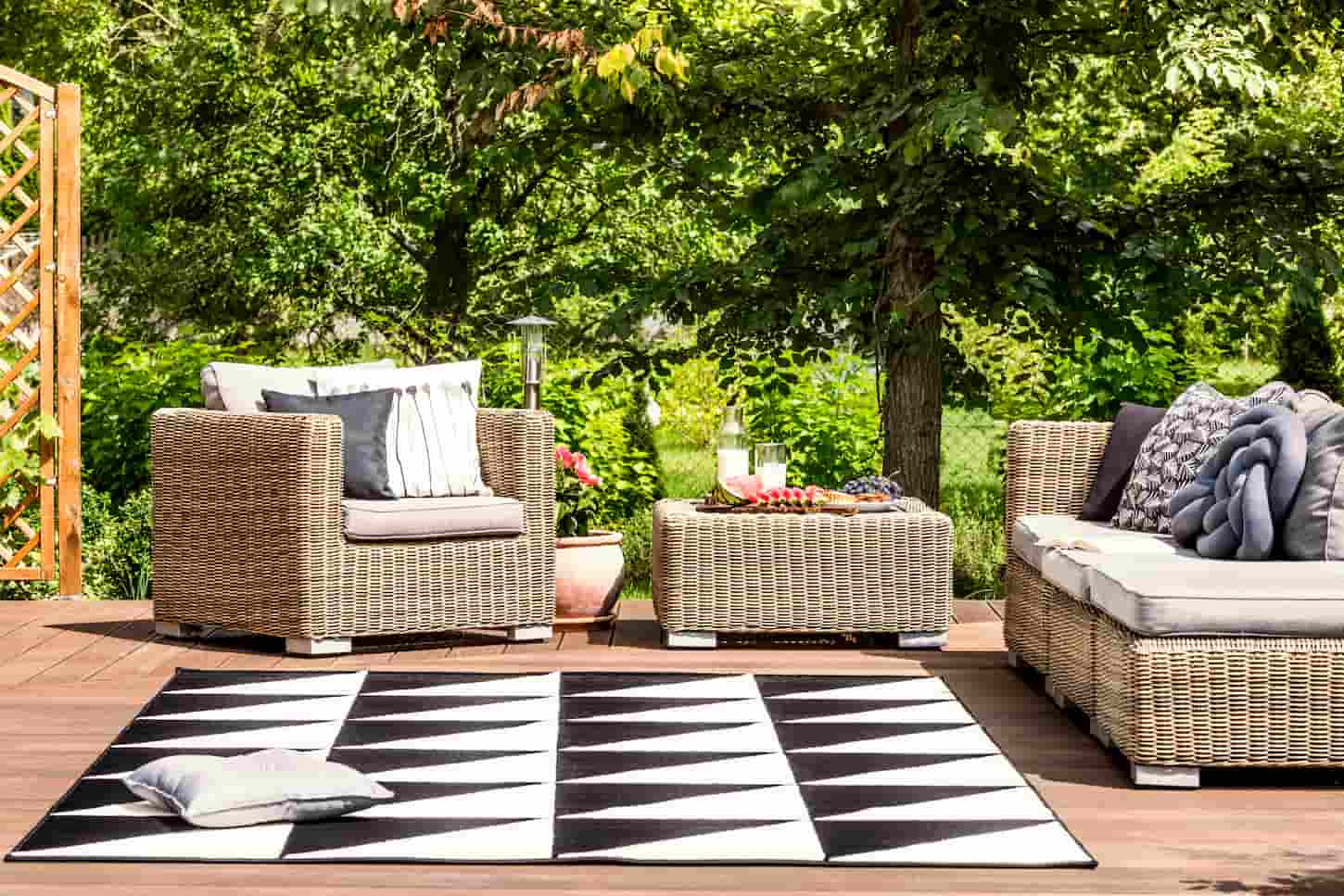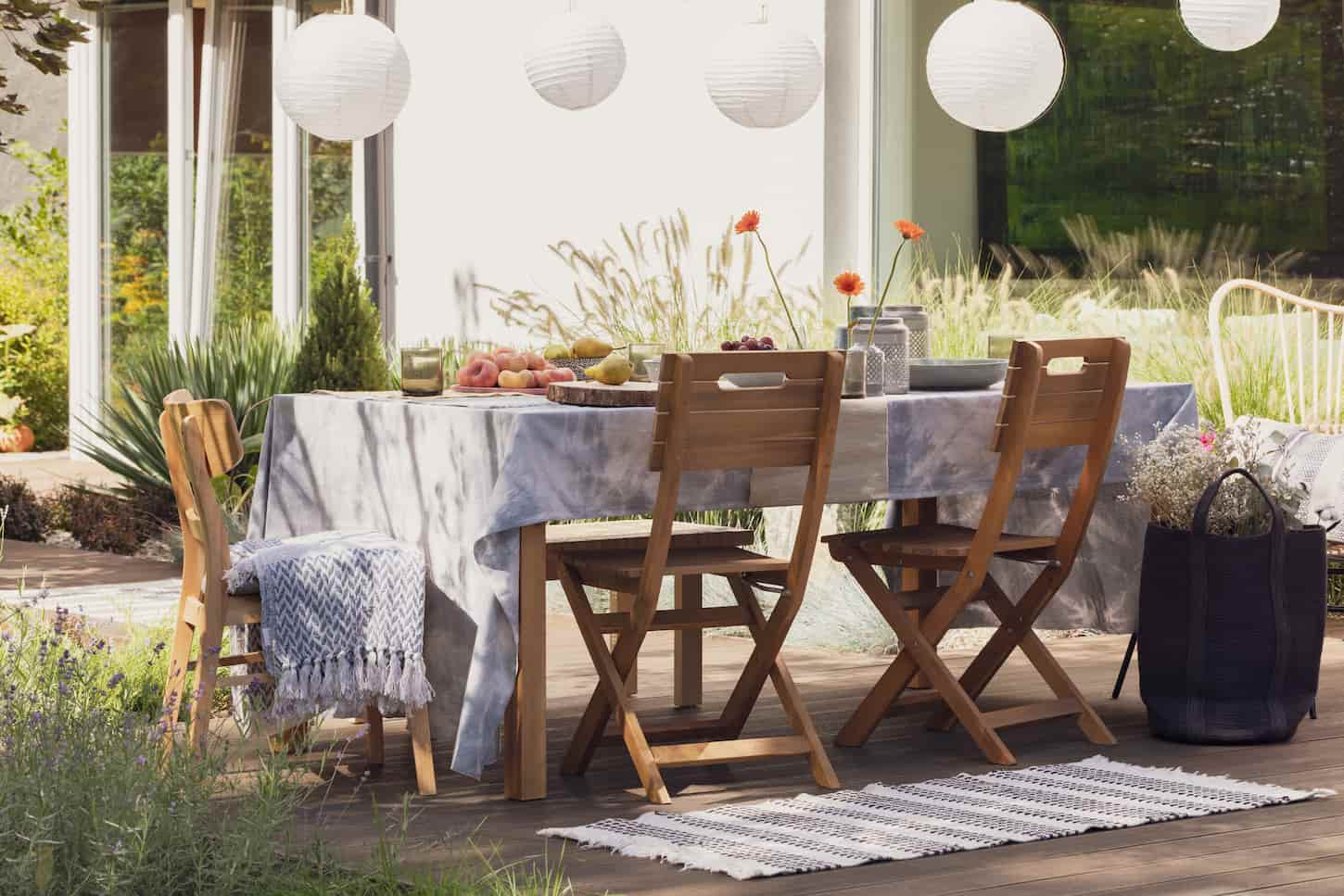If someone has a nice outdoor space, they probably spend a lot of time there in the summer. Most people treat their garden like an extension of their home, and there’s no reason we shouldn’t put the same effort into the external decor as we do indoors.
Outdoor rugs are a fantastic way to brighten your garden and protect a patio or decking from furniture and heavy traffic. The downside to outdoor rugs is that they might stain or damage the floor if they are not maintained correctly.
If we want to inject a bit of color into the garden, we might wonder about the benefits and drawbacks of using outdoor rugs.
There’s much to consider before buying an outdoor rug, such as the material, style, and what we want to use it for. To help us make the right decision, we’ll examine outdoor rugs’ pros and cons. We have listed them below.

Are Outdoor Rugs a Good Idea?
Outdoor rugs are a good idea to add color and comfort to an outside area. They will protect surfaces from furniture, moisture, and fading in the sun and ultimately prolong the floor’s life.
Rugs make an outdoor area feel cozier and look more inviting. They can also make an outdoor space more peaceful by reducing the sound of footsteps and furniture scraping. Outdoor rugs on decking or concrete patios protect the floor from spills and prevent wear and tear from heavy traffic.
What to Look For in an Outdoor Rug
The most crucial thing to look for in an outdoor rug is that it is made from weather-resistant materials such as PVC or bamboo. Outdoor rugs must also be lightweight with a shallow pile – so they dry easily. They come in many styles, so choose one that suits everyone’s tastes and needs.
Here are the three most important things to consider when buying an outdoor rug.
#1 – Right size
The rug size is one of the most important things to consider. If the rug is too small, it won’t offer adequate protection. If it’s too large, we will have to cut it down to size, and the edges won’t look nice.
Outdoor rugs come in many shapes and sizes, and we must choose one that fits our space. To ensure we select the right-sized rug, measure the area with a measuring tape.
If you want a rug to protect the floor from furniture, measure around the furniture and make sure to account for where chairs pull out.
#2 – Material
Outdoor rugs are made from synthetic or natural materials, and each has its own benefits. Natural fibers include jute, bamboo, hemp, seagrass, and sisal, and synthetic materials include polyester and polypropylene, recycled plastic, acrylic, and nylon.
Natural fibers are better for the environment because they’re made from sustainable materials. They are nicely woven with neutral colors and look more natural outdoors. The downside of natural fibers is that they can feel coarse underfoot and get moldy quickly if damp.
Rugs made from synthetic materials are less expensive and more durable than natural fiber styles. They come in many colors and styles and are easy to clean and maintain.
Rugs made from synthetic materials are perfect for damp spots because they’re mold resistant but will fade in the sun if they’re not UV resistant.
#3 – Your style and needs
An outdoor rug should complement a garden, so choose one that matches the deck, patio, and furniture. Natural fiber rugs look beautiful on light decking, while bright rugs bring life to a dark or shady corner.
If you need rugs for a wet place, like next to the pool, choose synthetic ones because they dry easier and are less prone to mold. For sunny, uncovered areas, choose UV-resistant synthetic rugs or natural fiber rugs for warm, dry, covered areas.
What Do You Put Under an Outdoor Carpet?
To help keep rugs in place, put a rug buffer or pad under an outdoor carpet. Rug buffers and pads help keep carpets in place and help prolong their life. Pads help the rug last longer because they act as a buffer to absorb friction between the carpet and the floor surface.
Most pads are non-slip and keep the rug firmly attached to the floor so it won’t bunch up or slide around. Outdoor rugs are thin, and a pad is a fantastic way to give them more depth, which makes them more protective and comfortable under the feet.
Outdoor rug pads differ from indoor pads because they’re thinner, more durable, and weather-resistant. The best materials for outdoor pads are natural rubber, PVC, or latex.
When choosing a pad, it must be 1 -2 inches smaller than the rug. Most regular rug sizes are easy to buy a pad for – they already come at the right size. However, if there isn’t one that’s the right size, we can usually cut them down to the right size by trimming the edges.
Rug pads absorb a lot of impact from traffic and furniture and will wear down over time, and we must replace them every 3 to 4 years or so, depending on wear and weather.
Are Outdoor Rugs Waterproof?
Outdoor rugs are usually water resistant rather than waterproof. This means they repel water and don’t absorb it, but they don’t prevent surfaces from getting wet in the rain. Water-resistant mats are breathable and quick drying and are less susceptible to mold.
If outdoor rugs get wet, we must hang them out to dry. If we don’t hang them out, water will sit under the mat and potentially cause dampness and staining on the floor surface.
If you aren’t sure if your rug is waterproof or water-resistant, get the rug wet. See how long it takes to dry. And see how quickly the floor under it dries. That’ll give you a great idea of how it deals with water – and if you want to keep that rug or replace it with another one.

Will an Outdoor Rug Ruin My Patio?
An outdoor rug won’t ruin a patio if we maintain them correctly. We must clean both regularly – especially underneath the rug, and remove wet rugs and dry them before replacing them.
A rug can stain a patio if we don’t dry it when it gets wet. Mold will form quickly underneath and cause staining on the floor.
Treated concrete patios are more stain-resistant, so it’s worth using a patio sealer to protect surfaces from rug stains. If a patio is untreated, a rug might darken it a little.
Don’t use rugs to cover a damaged area because it will become more damaged if people walk over it. Make sure the patio is in good condition before covering it with a rug. If it’s composite decking, avoid rugs with rubber or latex because they will stain.
Can Outdoor Rugs Be Left in the Rain?
Outdoor rugs are weatherproof, so it’s ok to leave them out in the rain. Synthetic ones are more water-resistant than natural fibers and are less likely to mold if wet.
If we leave rugs out in the rain, we must dry them and the floor underneath when they get wet. If we don’t, they will become moldy and may stain the floor.
Natural fiber rugs are particularly susceptible to mold if they are damp. To completely avoid mold, cover rugs or bring them in if the weather is due for heavy rainfall.
Can I Leave an Outdoor Rug Outside all the Time?
Potentially, we can leave an outdoor rug outside all the time – especially if we live in a warm climate. Most people bring their rugs in during the winter when they no longer use their outdoor space to prevent them from being damaged by harsh weather.
Leaving rugs outside in winter in a cold climate make it difficult to keep them dry and prevent mold, so it’s better to bring them in. Clean the rugs before removing them, and roll them up with the bottom on the outside for storage. We can also wrap them in plastic to protect them from insects.
5 Pros and Cons of Outdoor Rugs
The pros of outdoor rugs are that they beautify and add comfort to the yard and protect surfaces from the elements and furniture. The cons of outdoor rugs are that they are prone to mold if we do not clean them, which can damage surfaces.
Before buying an outdoor rug, there are five pros and cons you should know, which I’ve listed below.

Outdoor rugs – the pros
Here are the reasons why outdoor rugs reign supreme. And don’t forget – they can be used outdoors and/or inside.
Pro #1 – They’re durable
One of the best things about outdoor rugs is that they’re super durable, and if we maintain them correctly, they will last many years. Outdoor rugs are weather and water-resistant, and UV-treated polyester rugs won’t fade in the sun.
Pro #2 – They make the outside more comfortable
The decking and patios look nice, but they aren’t very comfortable. Adding rugs to an outdoor area makes it cozier and more inviting. An outdoor rug will absorb noise and reduce the sound of chairs scraping, people walking and paws tapping to make the yard more tranquil.
Pro # 3 – They’re easy to maintain
Outdoor rugs are stain-resistant and easy to maintain, and we can easily wipe up spills from them with a damp cloth. They’re easy to clean with a vacuum, broom, or leaf blower, or we can beat it or shake it off as we would with an indoor rug.
Some rugs can go in a washing machine, or we can rinse them with a hose. Always check with the manufacturer for cleaning recommendations.
Pro #4 – They protect your floor
Building a deck or patio in the garden isn’t cheap and using outdoor rugs is one of the best ways to protect the investment. Heavy outdoor furniture can scratch surfaces easily, and rugs are the best way to prevent scratches.
Rugs protect the floor from the sun, which can become discolored with prolonged exposure. They also protect surfaces from damage from heavy foot traffic.
Pro # 5 – They’re affordable
Another fantastic thing about outdoor rugs is that they’re affordable and less expensive than indoor ones. This means we can cover a large area without spending massive amounts of money. Outdoor rugs last for many years and are a worthwhile investment.

The Cons of outdoor rugs
Here’s when outdoor rugs may not be the best idea.
Con #1 – They might damage your patio
If we don’t clean our rugs regularly or dry them after they get wet, they can damage the floor beneath them. Also, rubber and latex can stain composite, wood decking, or untreated concrete patios.
Con #2 – They can slip if you don’t use a pad or buffer
If the outdoor mat slips or bunches up, not only is it annoying putting it back in place every 5 minutes. It also makes for a trip hazard. Tripping on a mat is dangerous, especially for children or older people.
Con #3 – They’re prone to mold
Outdoor rugs are generally durable and weather resistant, but if we don’t dry them out, they will mold, especially rugs made from natural fibers. If we keep natural fiber rugs in a damp, shady place, they will quickly gather mold.
Con #4 – PVC might be bad for your health
Some PVC rugs might be bad for our health and the environment because they contain highly Volatile Organic Compounds (VOCs).
A PVC rug with VOCs will release harmful particles into the air, and if we breathe them in, they can potentially cause respiratory irritation. Look for VOC-free polyester or recycled plastic when you choose a synthetic rug.
Con #5 – They’re not waterproof
Outdoor rugs are not waterproof – they are water resistant and won’t protect surfaces from rain. Hang outdoor rugs to dry each time they get wet – otherwise, they will mold.
Best Products For Outdoor Rugs
When you’re setting up your outdoor area, having the right products can make life much easier. Here are a few products we’ve found, liked, tested, or plan to test soon.
Indoor and Outdoor Rug options (traditional options)
- There are a ton of great options for indoor/outdoor rugs, like this Tribal patterned one here. It comes in various sizes and colors to complement the geometric pattern, making it a classic option for almost every decor style.
- If you prefer a more floral-looking (but still geometrical) rug, I’d check this indoor/outdoor rug out. It also comes in a variety of colors and sizes.
Indoor/Outdoor Rugs made from Bamboo or Plastic
- A bamboo area rug dries quickly, though I’d still hang it up when it gets wet to help it last longer. Bamboo rugs (like this awesome option here), can also come with non-slip backing, so you don’t have to buy that separately.
- Want to help recycle plastic? This outdoor rug option lets you do that while looking good and lasting a good while. It’s got a classy geometric pattern while coming in various colors and sizes, even.
If you want the most waterproof rug possible, then getting a plastic rug (preferably made from recycled plastic) is the way to go. This particular rug comes in a bunch of styles, designs, and sizes.
It’s where I’d start looking if I were in your shoes. We’ve got one of these in our RV for a traveling patio. It’s not as comfortable to sit on as a classic rug, but it’s sure a ton better than the dirt!
Best Rug Pads
- This kind of rug pad works great on surfaces that aren’t slick, so it works great on concrete, wood, or other composite wood surfaces. In my experience, though, it will bunch on the tile surfaces, so I don’t recommend it there. It can be cut to size easily and dries quickly when wet.
Key Takeaways and Next Steps
If we want outdoor rugs for your garden or patio, we should choose them according to our style and needs. If we need one for an uncovered damp area, we should choose synthetic rugs made from VOC-free PVC or recycled plastic.
Natural fibers, such as bamboo or jute, are better for dry, covered areas because they’re more prone to mold.
We can leave outdoor rugs out in the rain but hang them out to dry afterward, or they will quickly develop mold, which can stain the floor. If living in a cold climate, to prolong the life of the rugs, roll them up and store them inside for the winter.
We have an article packed with information about preventing scratching on your deck. To read it, click here.
Resources
Learning from your own experience is important, but learning from others is also smart. These sources were used in this article and our research to be more informed as we DIY and decorate our homestead.
- Bockrath Flooring & Rugs. “The PROS and CONS of Outdoor Rug Fibers.” Bockrath Flooring Rugs, 3 Aug. 2022, www.bockrathflooring.com/blog/articles/the-pros-and-cons-of-outdoor-rug-fibers.
- James, Larry. “Can You Put an Outdoor Rug on a Concrete Patio? (Fast Facts).” Take a Yard, 12 July 2022, takeayard.com/outdoor-rug-concrete-patio.
- Kocharian, By Anna. “Considering an Outdoor Rug? Here’s What Makes a Good One.” Consumer Reports, 21 Apr. 2021, www.consumerreports.org/outdoor-rugs/outdoor-rug-buying-guide-a6506976079.
- McDonald, Will. Do You Need a Pad for Your Outdoor Rug? (Yes – Here’s Why). 16 May 2022, www.rugpadusa.com/articles/best+outdoor+rug+pad.
- “Will an Outdoor Rug Damage a Wood Deck?” Captain Patio, 11 Oct. 2021, captainpatio.com/will-an-outdoor-rug-damage-a-wood-deck.